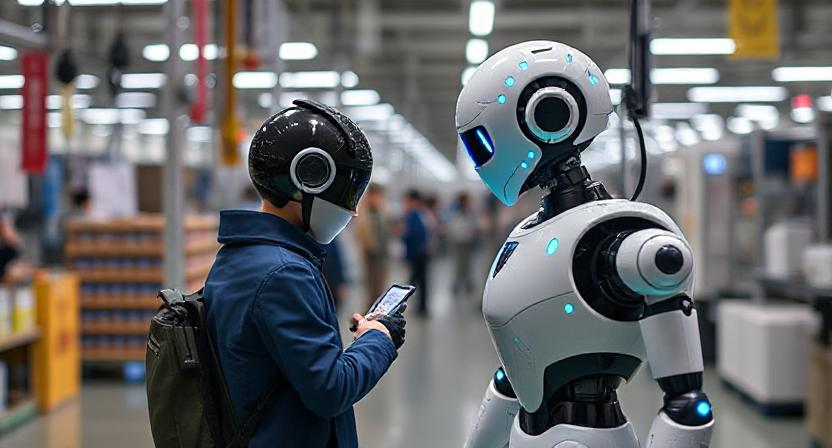China is embracing artificial intelligence, from educational tools to humanoid robots in factories
A New Companion for Timmy
Eight-year-old Timmy sits at his coffee table, eyes locked on a chessboard. Across from him, not a human opponent, but a small AI-powered robot. His hands rest on his head as he carefully considers his next move.
The first night the robot arrived, Timmy hugged it before heading to bed. He hasn’t given it a name yet, but he already sees it as more than just a machine.
“It’s like a little teacher or a little friend,” he says, showing his mother the move he’s planning.
A few moments later, the robot speaks:
“Congrats! You win.”
Its digital eyes blink as it begins resetting the pieces. “I’ve seen your ability. I will do better next time.”
This little robot is just one example of how AI is becoming an everyday presence in Chinese homes, schools, and workplaces.

China’s Big AI Ambitions
China has set an ambitious goal: to become a global AI superpower by 2030. The world got a glimpse of this vision in January with the launch of DeepSeek, an AI chatbot that caught international attention.
AI investment in China is booming:
- Over 4,500 AI companies are competing for market dominance.
- Primary and secondary schools in Beijing will introduce AI courses this year.
- Universities are increasing AI-related programs to train the next generation of engineers.
China’s AI push is backed by massive funding. Beijing has pledged 10 trillion yuan ($1.4 trillion USD) over the next 15 years. In January, a 60 billion yuan AI investment fund was created—just days after the U.S. tightened chip export restrictions against China.
Yet, despite U.S. sanctions, Chinese AI firms are proving they can keep up. DeepSeek’s rapid rise has stunned Silicon Valley, challenging assumptions about China’s technological capabilities.
AI-Powered Toys and Learning Tools
Timmy’s chess-playing robot was created by SenseRobot, a Chinese company that has sold over 100,000 units worldwide.
“Parents ask about the price, then where the product is from,” says Tommy Tang, a marketing executive at SenseRobot. “They expect the U.S. or Europe. When I say China, there’s always a moment of silence.”
SenseRobot isn’t the only AI toy company making waves. Whalesbot, a Shanghai-based startup, is helping children as young as three learn to code through AI-powered toys. Their building sets come with coding booklets, allowing kids to create and program their own interactive robots.
“Other countries have AI education robots too,” says Abbott Lyu, Vice President of Whalesbot. “But when it comes to smart hardware and competitiveness, China is ahead.”
A Race Among “Little Dragons”
China’s AI sector is now dominated by six rising stars, nicknamed the “Six Little Dragons”:
🔹 DeepSeek – AI chatbot rivaling ChatGPT
🔹 Unitree Robotics – Specializing in humanoid and quadruped robots
🔹 Deep Robotics – AI-powered search and rescue robots
🔹 BrainCo – Brain-machine interface technology
🔹 Game Science – AI-enhanced game development
🔹 Manycore Tech – Advanced AI computing hardware
At a recent AI exhibition in Shanghai, visitors watched as two teams of humanoid robots played a game of football, dressed in red and blue jerseys. When one robot fell, a human handler carried it off the field on a stretcher—keeping the joke alive.
“DeepSeek showed the world that we are here,” says Yu Jingji, a 26-year-old AI engineer.
AI and Privacy Concerns
As China’s AI power grows, so do global concerns about data privacy.
With over 1 billion mobile users (compared to 400 million in the U.S.), China has a massive data advantage. Western governments fear that AI tools like DeepSeek, RedNote, or TikTok could be used by the Chinese government to collect sensitive user data.
- South Korea has banned new downloads of DeepSeek.
- Taiwan and Australia have barred the app on government devices.
- The U.S. banned TikTok from government-issued phones over similar concerns.
Chinese companies insist they comply with privacy laws. Tommy Tang emphasizes: “Privacy is a red line for us.”
But Beijing is aware of the global scrutiny. A recent state-run Beijing Daily article admitted that China’s AI firms are facing increasing challenges in international markets.
China’s Strategy: AI for the Masses
Despite restrictions, China’s AI engineers are pushing forward. Their goal? To make AI more powerful and more affordable.
SenseRobot faced an early challenge: robotic arms for its chess-playing machine initially cost $40,000 to manufacture. By using AI to optimize the production process, the company cut costs to just $1,000.
“This is innovation,” says Tang. “AI engineering is now part of manufacturing itself.”
The implications are huge. China is already rolling out AI-powered humanoid robots in factories, warehouses, and even elderly care homes. In January, the government announced plans to expand the use of AI robots to assist China’s aging population.
A Long Race Ahead
President Xi Jinping is betting big on AI, seeing it as key to China’s “technological self-reliance.”
However, Chinese officials acknowledge that there’s still a long way to go. A recent Beijing Daily editorial warned that despite DeepSeek’s success, China remains in “catch-up mode.”
For now, China is sprinting ahead in the AI race—but the real competition is just beginning.
